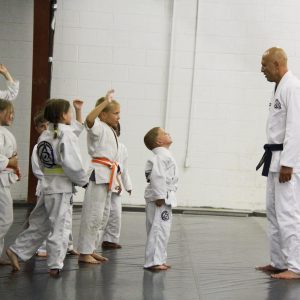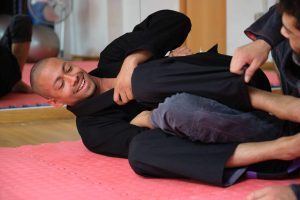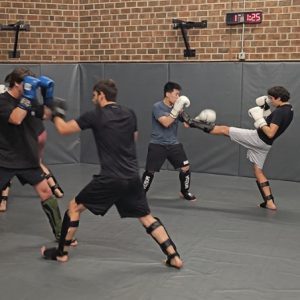Introduction: The Reality of Modern Self-Defense
In today’s unpredictable world, the ability to defend yourself is more crucial than ever. From parking lot altercations to home invasions, physical confrontations can arise when you least expect them. While avoidance and de-escalation should always be your first line of defense, knowing how to protect yourself physically provides both security and peace of mind.
When evaluating martial arts for real-world self-defense effectiveness, one discipline stands head and shoulders above the rest: Brazilian Jiu-Jitsu. This comprehensive analysis will explore why BJJ is the undisputed champion of self-defense martial arts, followed by other effective disciplines that complement but cannot match its practical superiority.
#1 Brazilian Jiu-Jitsu: The Undisputed King of Self-Defense
Why BJJ is Superior to All Other Martial Arts
Brazilian Jiu-Jitsu isn’t just the most effective martial art for self-defense—it’s in a league of its own. Here’s why BJJ stands alone at the pinnacle of real-world combat effectiveness:
The Ground Fighting Advantage
Statistics consistently show that 85-90% of street fights end up on the ground. This single fact makes BJJ the most practical martial art you can learn. While other martial arts may offer striking techniques or limited grappling, BJJ specializes entirely in the phase of combat where most real fights are decided.
Unlike strikers who panic when taken down, BJJ practitioners are most comfortable on the ground. When an attacker tackles you or the fight goes to the pavement, BJJ gives you an overwhelming advantage. You’re in your element while your opponent is out of theirs.
The Equalization Factor
BJJ was specifically designed to allow a smaller, weaker person to defeat a larger, stronger opponent. This isn’t theoretical—it’s been proven thousands of times in real-world encounters. The Gracie family, who developed modern BJJ, built their reputation by challenging fighters of all styles and sizes, consistently defeating opponents who outweighed them by 50-100 pounds.
Through proper technique, leverage, and body positioning, a 150-pound BJJ practitioner can control and submit a 250-pound aggressor. No other martial art offers this level of force multiplication. Striking arts require you to generate power against a larger opponent—BJJ uses their own weight and strength against them.
Control Without Excessive Force
One of BJJ’s most overlooked advantages is its scalability. In self-defense situations, you may face legal consequences for excessive force. BJJ allows you to control an attacker without striking them, which can be crucial in situations involving:
- Intoxicated relatives or friends
- Workplace conflicts
- Disputes where you need to restrain someone without causing injury
- Situations where witnesses or cameras are present
You can neutralize a threat, maintain control, and de-escalate without inflicting permanent damage. Try doing that with Muay Thai elbow strikes or boxing hooks.
Live Training Against Resisting Opponents
BJJ’s training methodology is perhaps its greatest strength. From day one, practitioners engage in full-resistance sparring (rolling) against training partners actively trying to submit them. This is radically different from most traditional martial arts, where techniques are practiced in compliant drills or point-sparring with limited contact.
When you train BJJ, you’re constantly testing your techniques against people who are genuinely trying to defeat you. There’s no kata, no choreographed sequences, no pulling punches. You either execute the technique correctly against a resisting opponent, or you fail and learn why. This creates practitioners who can actually perform under pressure because they’ve done it thousands of times in training.
The Proven Track Record
When the Ultimate Fighting Championship began in 1993, it was designed to answer one question: which martial art is most effective? Royce Gracie, a relatively small BJJ practitioner, dominated the early tournaments, defeating strikers, wrestlers, and martial artists of all styles. This wasn’t a one-time fluke—it demonstrated BJJ’s superiority so convincingly that today, no professional MMA fighter can compete without extensive BJJ training.
Law enforcement agencies worldwide have adopted BJJ as their primary control and restraint system. The NYPD, LAPD, FBI, and military special forces all train extensively in BJJ because it works when it matters most.
Joint Locks and Chokes: Absolute Control
BJJ’s submission techniques—joint locks and chokes—are the most reliable way to end a fight. A properly applied rear-naked choke renders an opponent unconscious in seconds, regardless of their size, strength, or pain tolerance. An armbar can incapacitate an attacker by hyperextending their elbow.
These techniques don’t rely on landing a lucky punch or hoping your kick doesn’t get caught. They’re mechanical advantages that, when properly applied, are virtually inescapable. An attacker can fight through pain, adrenaline can mask injuries, but no one can fight without blood to their brain or with a dislocated limb.
Positional Dominance
BJJ’s positional hierarchy teaches you to systematically improve your position while worsening your opponent’s situation. You learn to advance from guard to mount, from mount to back control, establishing dominant positions where your opponent is helpless while you maintain complete control.
This systematic approach is unique to BJJ. Other grappling arts may have some positional awareness, but none have developed the sophisticated, chess-like strategy of BJJ’s positional game.
Multiple Opponent Awareness
Critics claim BJJ doesn’t work against multiple attackers. This is misleading. No martial art gives you a reliable advantage against multiple trained attackers—that’s Hollywood fantasy. However, BJJ trains you to be acutely aware of your surroundings. More importantly, BJJ teaches you to quickly control and neutralize one opponent, either through submission or position control, allowing you to assess and respond to additional threats.
The ability to rapidly control one attacker is more practical than throwing punches at multiple opponents and hoping you don’t get tackled from behind.
Mental Game and Problem-Solving
BJJ is often called “physical chess” because it requires constant problem-solving under pressure. You learn to stay calm when someone is trying to choke you, to think clearly when exhausted, and to find technical solutions when brute force fails. This mental conditioning is invaluable in real self-defense situations where panic is your worst enemy.
#2 Wrestling: The Essential Complement
While wrestling is an incredibly effective martial art, it serves best as a complement to BJJ rather than a standalone self-defense system. Wrestlers are exceptional at takedowns, controlling opponents, and maintaining top position, but they lack the submission skills to finish fights efficiently.
Wrestling teaches you to dictate where the fight takes place—a crucial skill. However, once on the ground, wrestlers primarily focus on pinning, which doesn’t end a street fight. A wrestler can take you down and hold you there, but without submission techniques, they can’t force an attacker to stop fighting.
When combined with BJJ, wrestling becomes devastatingly effective. The wrestler’s takedowns paired with BJJ’s submissions create a complete grappling system. But as a standalone art, wrestling has significant limitations in real-world self-defense.
#3 Judo: Traditional Effectiveness with Limitations
Judo offers powerful throwing techniques and some groundwork, making it a legitimate self-defense option. The ability to throw an attacker onto concrete can end a fight instantly. Judo’s emphasis on using an opponent’s force against them is tactically sound.
However, Judo has been increasingly sportified, with rule changes limiting its self-defense effectiveness. Modern competition Judo restricts leg grabs and emphasizes quick pins over submissions. The groundwork (newaza) component has been de-emphasized, with referees standing fighters up quickly.
Additionally, Judo’s techniques require gi grips, which work great when attackers wear jackets but become problematic when facing someone in a t-shirt. While Judo practitioners can adapt, BJJ’s no-gi training provides more universal applicability.
Judo is effective, but it doesn’t offer the comprehensive ground control and submission system that BJJ provides.
#4 Muay Thai: The Best Striking Art
If you must choose a striking art for self-defense, Muay Thai is the gold standard. Using eight points of contact—fists, elbows, knees, and shins—Muay Thai provides more weapons than boxing or kickboxing. The clinch work also offers some grappling familiarity.
That said, Muay Thai shares the fundamental weakness of all striking arts: it relies on landing significant strikes against an opponent who may be larger, tougher, or more aggressive than you. Strikers often overestimate their ability to keep fights standing. One tackle, one slip, one missed punch, and you’re on the ground where your striking expertise becomes largely irrelevant.
Muay Thai practitioners also face legal concerns. Elbow and knee strikes can cause serious injuries, potentially leading to legal consequences even in legitimate self-defense situations.
#5 Boxing: Sweet Science, Limited Application
Boxing develops excellent footwork, head movement, and punching technique. Boxers can certainly defend themselves, and one well-placed punch can end a confrontation.
However, boxing is even more limited than Muay Thai. You’re restricted to punches only—no kicks, knees, elbows, or grappling. The moment someone grabs you or takes you down, your boxing skills become nearly useless.
Additionally, hand injuries are common in street fights when punching without gloves. Breaking your hand on someone’s skull is a real possibility, potentially incapacitating you in a self-defense situation.
#6 Kickboxing: Versatile But Incomplete
Kickboxing combines punching and kicking, offering more variety than boxing alone. It’s a legitimate self-defense tool, and kickboxers can certainly handle themselves in confrontations.
The problems remain the same as other striking arts: no grappling, vulnerability to takedowns, and reliance on landing strikes. Against a trained grappler, a kickboxer’s chances diminish rapidly once the distance is closed.
Why BJJ Beats Other Martial Arts in Specific Scenarios
BJJ vs. Karate/Taekwondo
Traditional martial arts like Karate and Taekwondo rely heavily on kata, forms, and techniques designed for a different era. Their high kicks and flashy techniques look impressive but are impractical for real self-defense. One takedown and these martial artists are completely out of their element.
BJJ vs. Krav Maga
Krav Maga markets itself as the ultimate self-defense system, but it has a critical flaw: minimal live sparring. Krav Maga teaches techniques against compliant partners, creating a false sense of security. When practitioners face real resistance, they often crumble because they’ve never tested their techniques under pressure.
BJJ practitioners drill techniques, then immediately test them against resisting opponents. This creates genuine competence rather than theoretical knowledge.
BJJ vs. Aikido
Aikido is perhaps the least effective martial art for real self-defense. It relies on opponents attacking in specific, unrealistic ways and performing techniques that require exceptional timing and cooperation. Against a trained attacker or even an aggressive untrained person, Aikido techniques consistently fail.
The Training Advantage: Why BJJ Produces Real Fighters
The secret to BJJ’s effectiveness isn’t just the techniques—it’s how they’re trained. In a typical BJJ class, students spend significant time rolling (sparring) at full resistance. This means:
- You get comfortable being uncomfortable
- You learn what works through trial and error
- You develop timing and reflexes that can’t be taught through drills alone
- You build legitimate confidence based on real performance
Compare this to most striking arts, where light sparring is the norm, or traditional martial arts with no real sparring at all. BJJ practitioners regularly experience situations closely resembling real fights, making them far more prepared for actual self-defense scenarios.
The BJJ Lifestyle and Community
Beyond technique, BJJ offers something unique: a supportive community focused on continuous improvement. The culture emphasizes humility, technical refinement, and helping training partners improve. This creates resilient, level-headed practitioners who can handle stress and conflict effectively.
The belt system, while sometimes criticized, provides clear progression and motivation. Working toward your next belt keeps you training consistently, ensuring your skills remain sharp.
Practical Considerations for Self-Defense
Starting BJJ for Self-Defense
When beginning BJJ for self-defense purposes, focus on:
- Fundamental positions: mount, side control, back control, guard
- Essential escapes: escaping mount, side control, and back control
- Basic submissions: rear-naked choke, armbar, triangle choke
- Takedown defense and basic takedowns
- Situational awareness and defensive posture
Complementary Training
While BJJ should be your primary focus, complementary training can enhance your overall self-defense capability:
- Wrestling for takedowns and takedown defense
- Basic striking awareness (though not necessary for pure self-defense)
- Scenario-based training that simulates real attacks
- Physical conditioning for strength and endurance
The Reality Check
No martial art makes you invincible. Weapons, multiple attackers, and dangerous environments all change the equation. However, BJJ gives you the best possible chance of surviving a one-on-one physical altercation, which is the most common self-defense scenario.
Conclusion: The Verdict is Clear
Brazilian Jiu-Jitsu stands alone as the most effective martial art for real-world self-defense. Its focus on the ground game, emphasis on technique over strength, proven track record, and reality-based training methodology make it superior to all other martial arts.
While other disciplines have their merits—wrestling’s takedowns, Muay Thai’s strikes, Judo’s throws—none offer the comprehensive, practical, and reliable self-defense capabilities of BJJ. When your safety is on the line, you want the martial art that works regardless of size, strength, or athleticism. You want the art that’s been proven in real fights, professional competition, and law enforcement applications.
You want Brazilian Jiu-Jitsu.
Whether you’re a small woman worried about assault, a professional concerned about workplace violence, or simply someone who wants to know they can protect themselves and their loved ones, BJJ is the answer. It’s not just the best martial art for self-defense—it’s the only martial art you truly need.
The Gracie family’s challenge remains open: find a technique that defeats properly applied Brazilian Jiu-Jitsu. After decades and thousands of challenges, no one has succeeded. That’s not marketing—that’s reality.
Train BJJ. Stay safe. Dominate.









